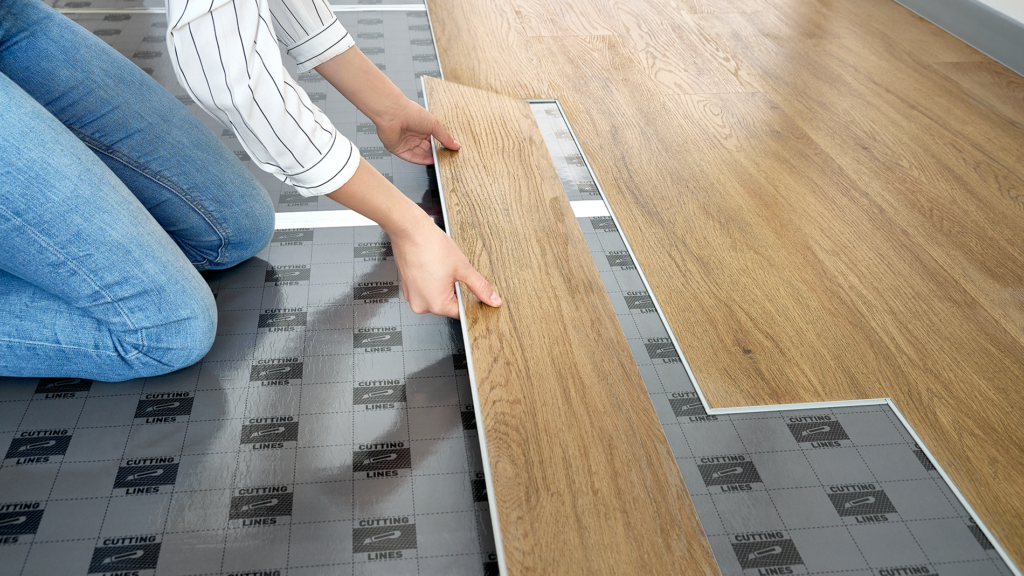You’ve finally decided to update your floors with stylish and durable roll vinyl flooring. You’re excited about the endless design possibilities and the prospect of easy maintenance. But a question lingers: Do you need underlayment beneath your roll vinyl flooring?

Image: flooringstype.com
The answer is not always a straightforward “yes” or “no.” It depends on several factors, including the type of roll vinyl, the subfloor condition, and your desired outcome. Understanding the pros and cons of using underlay will help you make an informed decision that ensures a beautiful and long-lasting flooring installation.
Understanding Roll Vinyl Flooring
Roll vinyl flooring, also known as sheet vinyl, is a popular choice for various spaces due to its affordability, durability, and ease of maintenance. It’s water-resistant, making it ideal for kitchens, bathrooms, and basements. Roll vinyl is also available in countless colors, patterns, and textures, allowing for a personalized look to suit any decor.
The Purpose of Underlayment
Underlayment is a layer of material installed beneath your flooring to provide additional benefits, including:
- Sound Dampening: Underlay reduces noise transmission between floors, minimizing echoes and footsteps for a quieter environment.
- Comfort and Support: It adds a layer of cushioning, making the flooring feel softer and more comfortable to walk on, especially beneficial in high-traffic areas.
- Subfloor Leveling: Underlay can help compensate for slight imperfections in the subfloor, creating a more even surface for a smoother installation.
- Moisture Barrier: Some underlay materials offer a moisture barrier, protecting your flooring from potential damage caused by spills or leaks.
- Insulation: Certain underlay types can help improve the thermal insulation of your floor, contributing to a more comfortable indoor environment.
Do You Need Underlay for Roll Vinyl Flooring?
While underlayment can enhance the performance and lifespan of your roll vinyl flooring, it is not always necessary. Here are factors to consider:

Image: flooracademy.co.uk
1. The Condition of Your Subfloor
- Smooth and Level Subfloor: If your subfloor is already smooth, level, and in good condition, you may not require underlayment. Roll vinyl flooring is relatively forgiving and can adapt to minor irregularities.
- Uneven or Rough Subfloor: If your subfloor has noticeable imperfections or is uneven, underlay is highly recommended to create a level surface for installation and prevent the flooring from buckling or cracking.
- Damaged or Weak Subfloor: If your subfloor is damaged or weak, underlayment will not be enough to address the problem. Repair or replace the subfloor first before installing the flooring.
2. The Type of Roll Vinyl Flooring
- Luxury Vinyl Tile (LVT): LVT is generally thinner than standard roll vinyl. Because of its thinness, underlayment is often recommended to provide additional cushioning, sound insulation, and support.
- Standard Roll Vinyl: Standard roll vinyl is thicker and may be installed without underlayment on a smooth and level subfloor. However, if you seek additional comfort, soundproofing, or insulation, using underlay is a smart choice.
3. Your Desired Outcome
- Optimal Comfort: If you prioritize a soft and comfortable walking surface, underlayment is a good investment, enhancing the overall feel of your flooring.
- Noise Reduction: If you want to minimize noise transmission between floors, underlayment is crucial, effectively dampening sound and creating a quieter environment.
- Waterproofing: If you’re installing roll vinyl flooring in a high-moisture area like a bathroom or basement, consider underlayment with a built-in moisture barrier to protect your floor and prevent damage.
Types of Underlayment
There are various types of underlayment available, each offering unique benefits. Common options include:
1. Foam Underlayment:
This popular option is made from closed-cell foam and provides excellent cushioning, sound absorption, and thermal insulation. Foam underlay is relatively affordable and easy to install. However, it may not be as effective at leveling uneven subfloors as other types.
2. Cork Underlayment:
Cork underlay is a natural and sustainable option known for its durability, cushioning, and soundproofing properties. It also provides excellent thermal insulation and is relatively moisture-resistant. However, cork underlay can be more expensive than foam underlay.
3. Rubber Underlayment:
Rubber underlay is a durable and resilient option that excels at sound absorption and cushioning. It provides a good level of moisture resistance and is often used in high-traffic areas.
4. Fiberboard Underlayment:
Fiberboard underlay is a dense and rigid option that provides excellent support and levelness. It is often used in conjunction with other types of underlay to enhance its performance. However, fiberboard underlay is typically less comfortable and more susceptible to moisture damage than other options.
Choosing the Right Underlay
The best underlay for your roll vinyl flooring depends on individual needs and preferences. Consider these factors:
- Subfloor Condition: If your subfloor is uneven, a more rigid underlay, like fiberboard, may be necessary. However, if the subfloor is smooth and level, a softer underlay like foam or cork can be sufficient.
- Sound Reduction: If noise reduction is a priority, opt for foam, cork, or rubber underlay, as these materials provide superior sound absorption.
- Comfort: If you desire a comfortable walking surface, foam or cork underlay is a great choice, providing a softer and more forgiving feel.
- Moisture Resistance: If you’re installing roll vinyl flooring in a high-moisture area, consider an underlay with a built-in moisture barrier to prevent damage.
- Budget: Foam underlay is the most budget-friendly option, while cork and rubber underlay can be more expensive.
Do You Need Underlay For Roll Vinyl Flooring
Conclusion
Whether or not you need underlay for your roll vinyl flooring is a decision based on several factors. Evaluating your subfloor condition, the type of roll vinyl, and your desired outcome will guide you toward the best choice. By understanding the benefits of underlay and considering the various options available, you can ensure a successful installation that delivers a beautiful, durable, and comfortable flooring solution. Remember to consult with a flooring professional for personalized advice and assistance in making the right choice for your specific needs.





